A Comprehensive Analysis: Tobacco Control Policies in Australia
VerifiedAdded on 2023/06/10
|7
|1862
|468
Report
AI Summary
This report examines the Framework Convention on Tobacco Control (FCTC) policy introduced by the Australian government to address the public health concern of tobacco consumption. It details the history of the policy, starting with its adoption in 1991, and discusses the reasons for its implementation, which include improving the nation's health status, reducing social burden, and preventing tobacco use. The report further explores the impact of the policy on Australian society, noting a reduction in tobacco consumption and related deaths, while also acknowledging economic impacts. Ultimately, the report concludes that the FCTC policy has been instrumental in promoting healthier lifestyles and raising awareness about the risks associated with smoking in Australia.
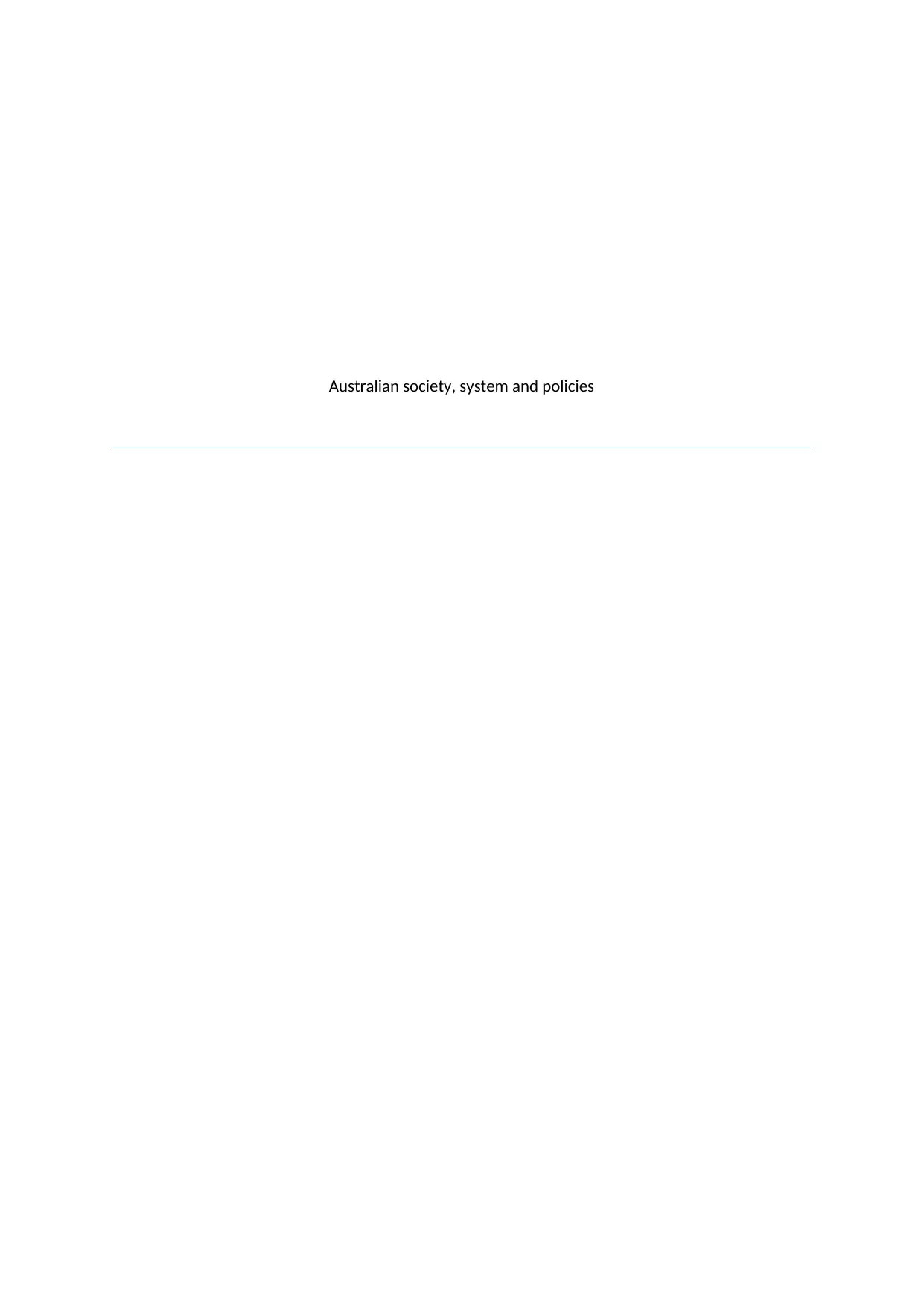
Australian society, system and policies
Secure Best Marks with AI Grader
Need help grading? Try our AI Grader for instant feedback on your assignments.
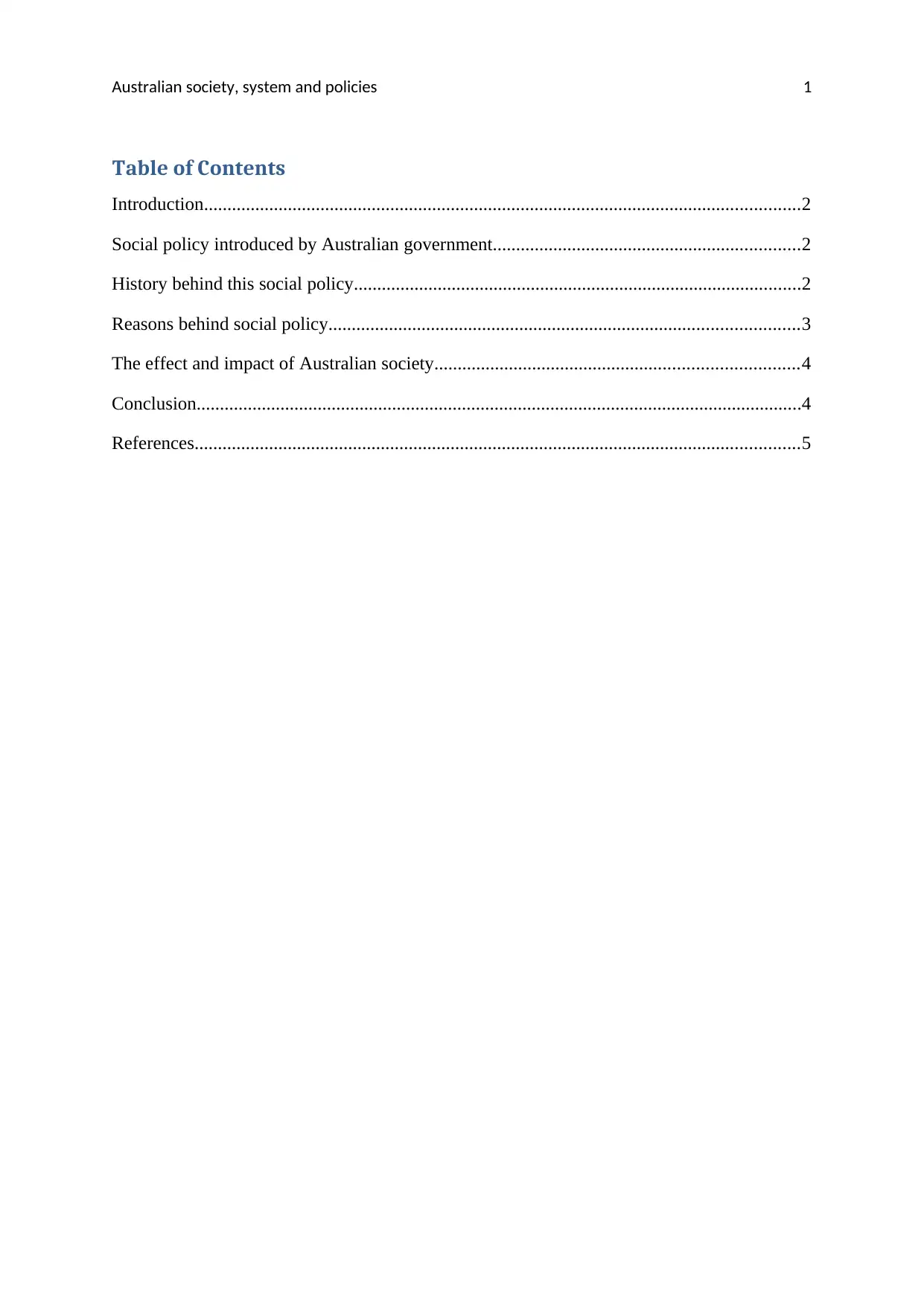
Australian society, system and policies 1
Table of Contents
Introduction................................................................................................................................2
Social policy introduced by Australian government..................................................................2
History behind this social policy................................................................................................2
Reasons behind social policy.....................................................................................................3
The effect and impact of Australian society..............................................................................4
Conclusion..................................................................................................................................4
References..................................................................................................................................5
Table of Contents
Introduction................................................................................................................................2
Social policy introduced by Australian government..................................................................2
History behind this social policy................................................................................................2
Reasons behind social policy.....................................................................................................3
The effect and impact of Australian society..............................................................................4
Conclusion..................................................................................................................................4
References..................................................................................................................................5
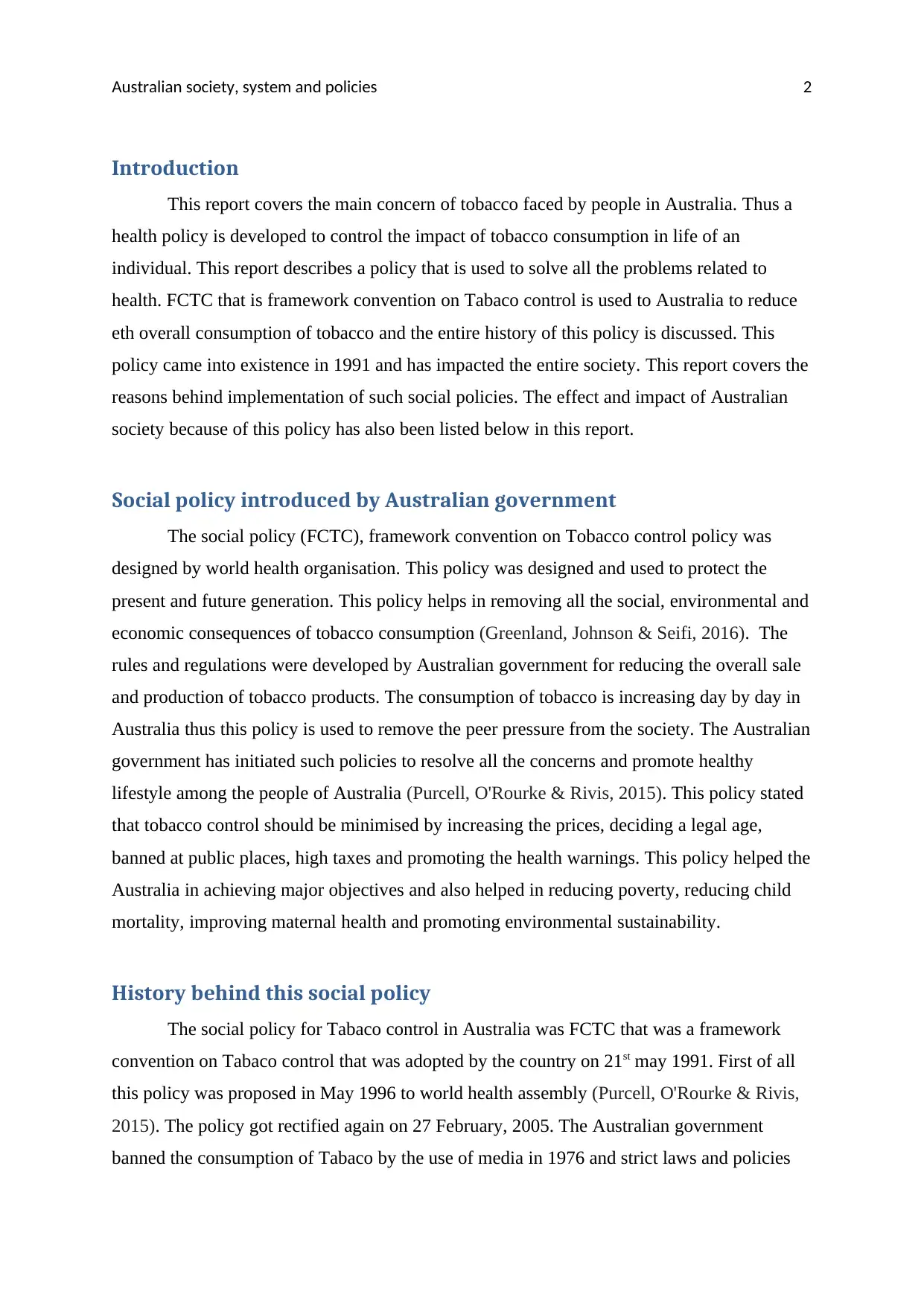
Australian society, system and policies 2
Introduction
This report covers the main concern of tobacco faced by people in Australia. Thus a
health policy is developed to control the impact of tobacco consumption in life of an
individual. This report describes a policy that is used to solve all the problems related to
health. FCTC that is framework convention on Tabaco control is used to Australia to reduce
eth overall consumption of tobacco and the entire history of this policy is discussed. This
policy came into existence in 1991 and has impacted the entire society. This report covers the
reasons behind implementation of such social policies. The effect and impact of Australian
society because of this policy has also been listed below in this report.
Social policy introduced by Australian government
The social policy (FCTC), framework convention on Tobacco control policy was
designed by world health organisation. This policy was designed and used to protect the
present and future generation. This policy helps in removing all the social, environmental and
economic consequences of tobacco consumption (Greenland, Johnson & Seifi, 2016). The
rules and regulations were developed by Australian government for reducing the overall sale
and production of tobacco products. The consumption of tobacco is increasing day by day in
Australia thus this policy is used to remove the peer pressure from the society. The Australian
government has initiated such policies to resolve all the concerns and promote healthy
lifestyle among the people of Australia (Purcell, O'Rourke & Rivis, 2015). This policy stated
that tobacco control should be minimised by increasing the prices, deciding a legal age,
banned at public places, high taxes and promoting the health warnings. This policy helped the
Australia in achieving major objectives and also helped in reducing poverty, reducing child
mortality, improving maternal health and promoting environmental sustainability.
History behind this social policy
The social policy for Tabaco control in Australia was FCTC that was a framework
convention on Tabaco control that was adopted by the country on 21st may 1991. First of all
this policy was proposed in May 1996 to world health assembly (Purcell, O'Rourke & Rivis,
2015). The policy got rectified again on 27 February, 2005. The Australian government
banned the consumption of Tabaco by the use of media in 1976 and strict laws and policies
Introduction
This report covers the main concern of tobacco faced by people in Australia. Thus a
health policy is developed to control the impact of tobacco consumption in life of an
individual. This report describes a policy that is used to solve all the problems related to
health. FCTC that is framework convention on Tabaco control is used to Australia to reduce
eth overall consumption of tobacco and the entire history of this policy is discussed. This
policy came into existence in 1991 and has impacted the entire society. This report covers the
reasons behind implementation of such social policies. The effect and impact of Australian
society because of this policy has also been listed below in this report.
Social policy introduced by Australian government
The social policy (FCTC), framework convention on Tobacco control policy was
designed by world health organisation. This policy was designed and used to protect the
present and future generation. This policy helps in removing all the social, environmental and
economic consequences of tobacco consumption (Greenland, Johnson & Seifi, 2016). The
rules and regulations were developed by Australian government for reducing the overall sale
and production of tobacco products. The consumption of tobacco is increasing day by day in
Australia thus this policy is used to remove the peer pressure from the society. The Australian
government has initiated such policies to resolve all the concerns and promote healthy
lifestyle among the people of Australia (Purcell, O'Rourke & Rivis, 2015). This policy stated
that tobacco control should be minimised by increasing the prices, deciding a legal age,
banned at public places, high taxes and promoting the health warnings. This policy helped the
Australia in achieving major objectives and also helped in reducing poverty, reducing child
mortality, improving maternal health and promoting environmental sustainability.
History behind this social policy
The social policy for Tabaco control in Australia was FCTC that was a framework
convention on Tabaco control that was adopted by the country on 21st may 1991. First of all
this policy was proposed in May 1996 to world health assembly (Purcell, O'Rourke & Rivis,
2015). The policy got rectified again on 27 February, 2005. The Australian government
banned the consumption of Tabaco by the use of media in 1976 and strict laws and policies
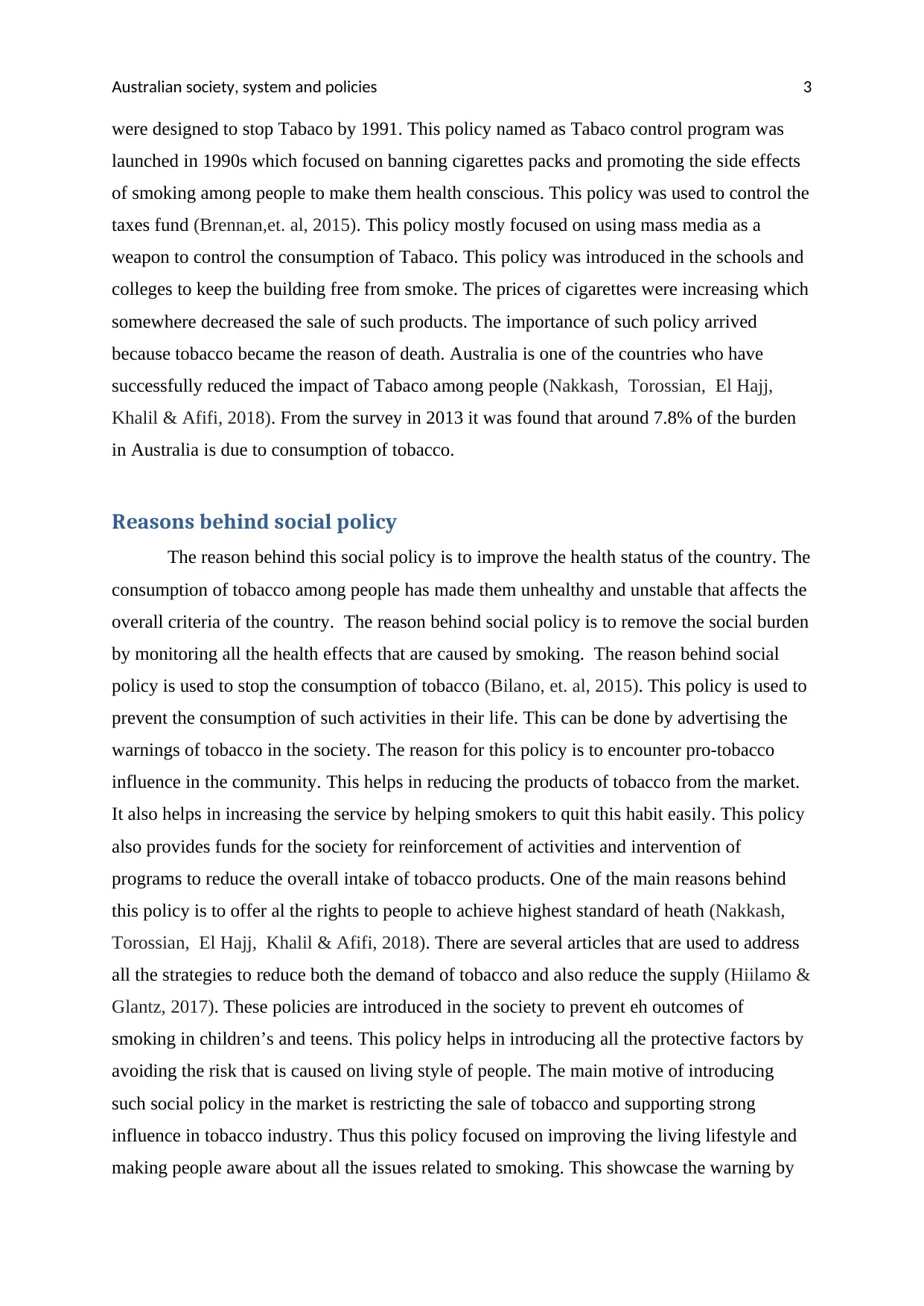
Australian society, system and policies 3
were designed to stop Tabaco by 1991. This policy named as Tabaco control program was
launched in 1990s which focused on banning cigarettes packs and promoting the side effects
of smoking among people to make them health conscious. This policy was used to control the
taxes fund (Brennan,et. al, 2015). This policy mostly focused on using mass media as a
weapon to control the consumption of Tabaco. This policy was introduced in the schools and
colleges to keep the building free from smoke. The prices of cigarettes were increasing which
somewhere decreased the sale of such products. The importance of such policy arrived
because tobacco became the reason of death. Australia is one of the countries who have
successfully reduced the impact of Tabaco among people (Nakkash, Torossian, El Hajj,
Khalil & Afifi, 2018). From the survey in 2013 it was found that around 7.8% of the burden
in Australia is due to consumption of tobacco.
Reasons behind social policy
The reason behind this social policy is to improve the health status of the country. The
consumption of tobacco among people has made them unhealthy and unstable that affects the
overall criteria of the country. The reason behind social policy is to remove the social burden
by monitoring all the health effects that are caused by smoking. The reason behind social
policy is used to stop the consumption of tobacco (Bilano, et. al, 2015). This policy is used to
prevent the consumption of such activities in their life. This can be done by advertising the
warnings of tobacco in the society. The reason for this policy is to encounter pro-tobacco
influence in the community. This helps in reducing the products of tobacco from the market.
It also helps in increasing the service by helping smokers to quit this habit easily. This policy
also provides funds for the society for reinforcement of activities and intervention of
programs to reduce the overall intake of tobacco products. One of the main reasons behind
this policy is to offer al the rights to people to achieve highest standard of heath (Nakkash,
Torossian, El Hajj, Khalil & Afifi, 2018). There are several articles that are used to address
all the strategies to reduce both the demand of tobacco and also reduce the supply (Hiilamo &
Glantz, 2017). These policies are introduced in the society to prevent eh outcomes of
smoking in children’s and teens. This policy helps in introducing all the protective factors by
avoiding the risk that is caused on living style of people. The main motive of introducing
such social policy in the market is restricting the sale of tobacco and supporting strong
influence in tobacco industry. Thus this policy focused on improving the living lifestyle and
making people aware about all the issues related to smoking. This showcase the warning by
were designed to stop Tabaco by 1991. This policy named as Tabaco control program was
launched in 1990s which focused on banning cigarettes packs and promoting the side effects
of smoking among people to make them health conscious. This policy was used to control the
taxes fund (Brennan,et. al, 2015). This policy mostly focused on using mass media as a
weapon to control the consumption of Tabaco. This policy was introduced in the schools and
colleges to keep the building free from smoke. The prices of cigarettes were increasing which
somewhere decreased the sale of such products. The importance of such policy arrived
because tobacco became the reason of death. Australia is one of the countries who have
successfully reduced the impact of Tabaco among people (Nakkash, Torossian, El Hajj,
Khalil & Afifi, 2018). From the survey in 2013 it was found that around 7.8% of the burden
in Australia is due to consumption of tobacco.
Reasons behind social policy
The reason behind this social policy is to improve the health status of the country. The
consumption of tobacco among people has made them unhealthy and unstable that affects the
overall criteria of the country. The reason behind social policy is to remove the social burden
by monitoring all the health effects that are caused by smoking. The reason behind social
policy is used to stop the consumption of tobacco (Bilano, et. al, 2015). This policy is used to
prevent the consumption of such activities in their life. This can be done by advertising the
warnings of tobacco in the society. The reason for this policy is to encounter pro-tobacco
influence in the community. This helps in reducing the products of tobacco from the market.
It also helps in increasing the service by helping smokers to quit this habit easily. This policy
also provides funds for the society for reinforcement of activities and intervention of
programs to reduce the overall intake of tobacco products. One of the main reasons behind
this policy is to offer al the rights to people to achieve highest standard of heath (Nakkash,
Torossian, El Hajj, Khalil & Afifi, 2018). There are several articles that are used to address
all the strategies to reduce both the demand of tobacco and also reduce the supply (Hiilamo &
Glantz, 2017). These policies are introduced in the society to prevent eh outcomes of
smoking in children’s and teens. This policy helps in introducing all the protective factors by
avoiding the risk that is caused on living style of people. The main motive of introducing
such social policy in the market is restricting the sale of tobacco and supporting strong
influence in tobacco industry. Thus this policy focused on improving the living lifestyle and
making people aware about all the issues related to smoking. This showcase the warning by
Secure Best Marks with AI Grader
Need help grading? Try our AI Grader for instant feedback on your assignments.
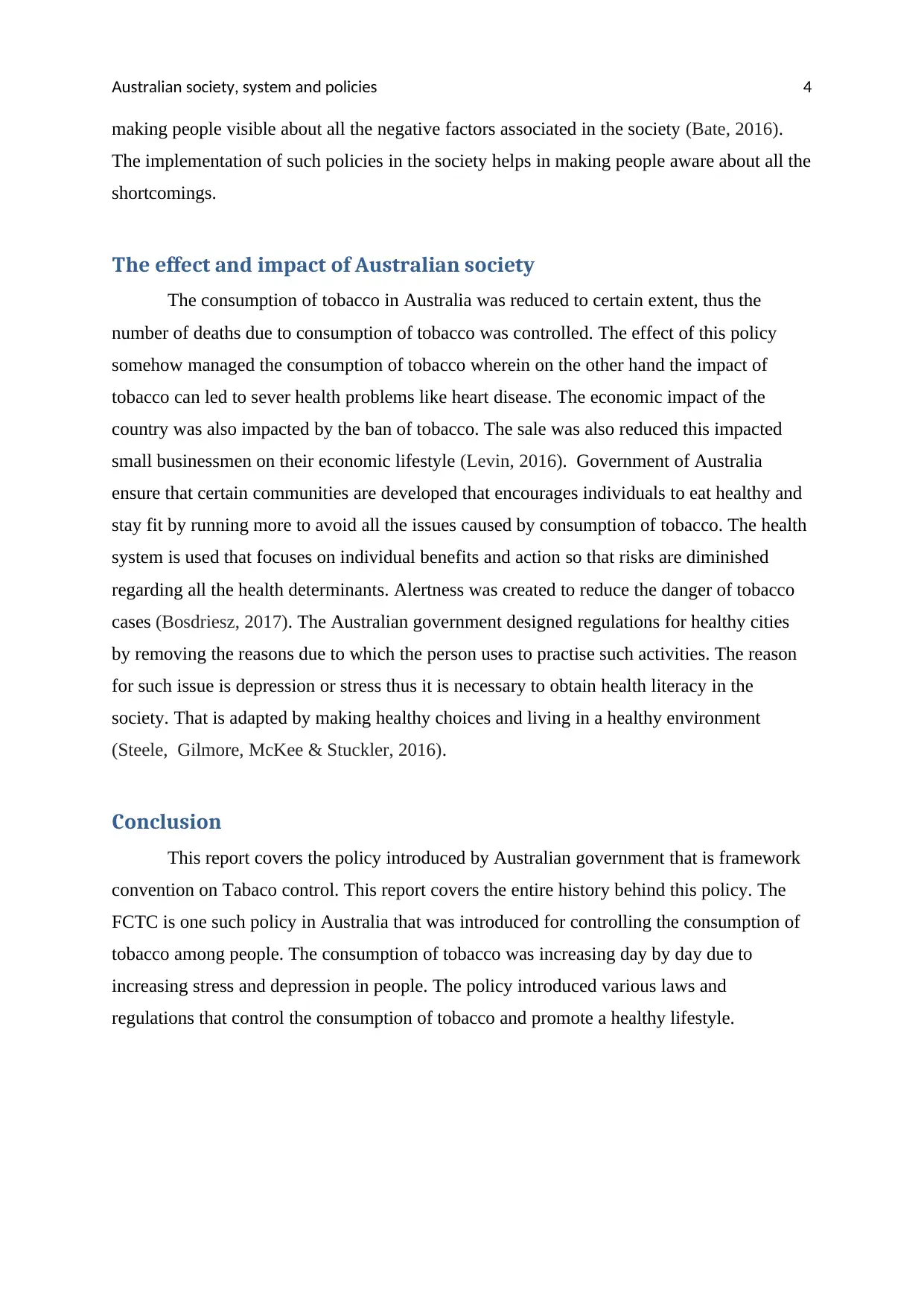
Australian society, system and policies 4
making people visible about all the negative factors associated in the society (Bate, 2016).
The implementation of such policies in the society helps in making people aware about all the
shortcomings.
The effect and impact of Australian society
The consumption of tobacco in Australia was reduced to certain extent, thus the
number of deaths due to consumption of tobacco was controlled. The effect of this policy
somehow managed the consumption of tobacco wherein on the other hand the impact of
tobacco can led to sever health problems like heart disease. The economic impact of the
country was also impacted by the ban of tobacco. The sale was also reduced this impacted
small businessmen on their economic lifestyle (Levin, 2016). Government of Australia
ensure that certain communities are developed that encourages individuals to eat healthy and
stay fit by running more to avoid all the issues caused by consumption of tobacco. The health
system is used that focuses on individual benefits and action so that risks are diminished
regarding all the health determinants. Alertness was created to reduce the danger of tobacco
cases (Bosdriesz, 2017). The Australian government designed regulations for healthy cities
by removing the reasons due to which the person uses to practise such activities. The reason
for such issue is depression or stress thus it is necessary to obtain health literacy in the
society. That is adapted by making healthy choices and living in a healthy environment
(Steele, Gilmore, McKee & Stuckler, 2016).
Conclusion
This report covers the policy introduced by Australian government that is framework
convention on Tabaco control. This report covers the entire history behind this policy. The
FCTC is one such policy in Australia that was introduced for controlling the consumption of
tobacco among people. The consumption of tobacco was increasing day by day due to
increasing stress and depression in people. The policy introduced various laws and
regulations that control the consumption of tobacco and promote a healthy lifestyle.
making people visible about all the negative factors associated in the society (Bate, 2016).
The implementation of such policies in the society helps in making people aware about all the
shortcomings.
The effect and impact of Australian society
The consumption of tobacco in Australia was reduced to certain extent, thus the
number of deaths due to consumption of tobacco was controlled. The effect of this policy
somehow managed the consumption of tobacco wherein on the other hand the impact of
tobacco can led to sever health problems like heart disease. The economic impact of the
country was also impacted by the ban of tobacco. The sale was also reduced this impacted
small businessmen on their economic lifestyle (Levin, 2016). Government of Australia
ensure that certain communities are developed that encourages individuals to eat healthy and
stay fit by running more to avoid all the issues caused by consumption of tobacco. The health
system is used that focuses on individual benefits and action so that risks are diminished
regarding all the health determinants. Alertness was created to reduce the danger of tobacco
cases (Bosdriesz, 2017). The Australian government designed regulations for healthy cities
by removing the reasons due to which the person uses to practise such activities. The reason
for such issue is depression or stress thus it is necessary to obtain health literacy in the
society. That is adapted by making healthy choices and living in a healthy environment
(Steele, Gilmore, McKee & Stuckler, 2016).
Conclusion
This report covers the policy introduced by Australian government that is framework
convention on Tabaco control. This report covers the entire history behind this policy. The
FCTC is one such policy in Australia that was introduced for controlling the consumption of
tobacco among people. The consumption of tobacco was increasing day by day due to
increasing stress and depression in people. The policy introduced various laws and
regulations that control the consumption of tobacco and promote a healthy lifestyle.
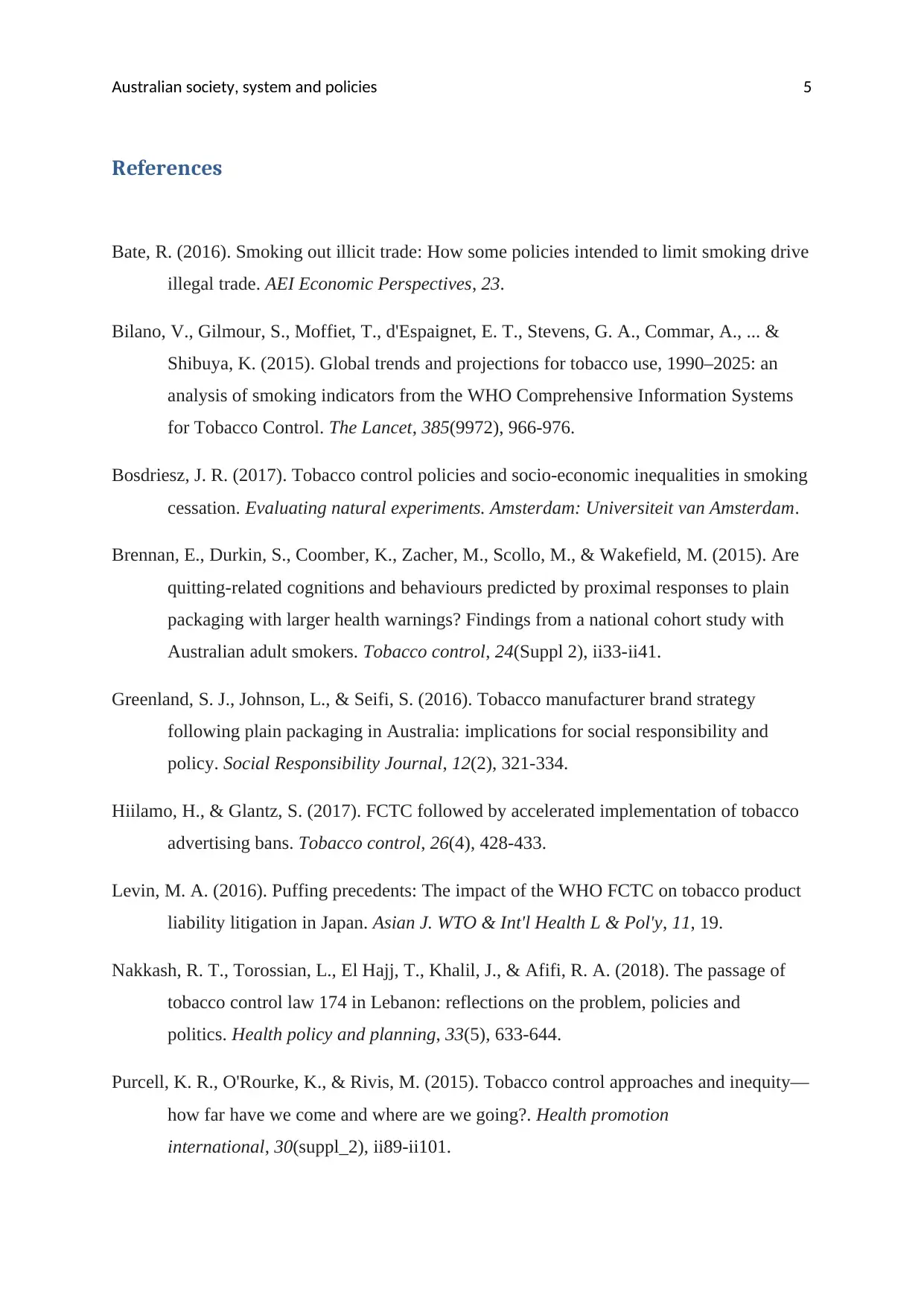
Australian society, system and policies 5
References
Bate, R. (2016). Smoking out illicit trade: How some policies intended to limit smoking drive
illegal trade. AEI Economic Perspectives, 23.
Bilano, V., Gilmour, S., Moffiet, T., d'Espaignet, E. T., Stevens, G. A., Commar, A., ... &
Shibuya, K. (2015). Global trends and projections for tobacco use, 1990–2025: an
analysis of smoking indicators from the WHO Comprehensive Information Systems
for Tobacco Control. The Lancet, 385(9972), 966-976.
Bosdriesz, J. R. (2017). Tobacco control policies and socio-economic inequalities in smoking
cessation. Evaluating natural experiments. Amsterdam: Universiteit van Amsterdam.
Brennan, E., Durkin, S., Coomber, K., Zacher, M., Scollo, M., & Wakefield, M. (2015). Are
quitting-related cognitions and behaviours predicted by proximal responses to plain
packaging with larger health warnings? Findings from a national cohort study with
Australian adult smokers. Tobacco control, 24(Suppl 2), ii33-ii41.
Greenland, S. J., Johnson, L., & Seifi, S. (2016). Tobacco manufacturer brand strategy
following plain packaging in Australia: implications for social responsibility and
policy. Social Responsibility Journal, 12(2), 321-334.
Hiilamo, H., & Glantz, S. (2017). FCTC followed by accelerated implementation of tobacco
advertising bans. Tobacco control, 26(4), 428-433.
Levin, M. A. (2016). Puffing precedents: The impact of the WHO FCTC on tobacco product
liability litigation in Japan. Asian J. WTO & Int'l Health L & Pol'y, 11, 19.
Nakkash, R. T., Torossian, L., El Hajj, T., Khalil, J., & Afifi, R. A. (2018). The passage of
tobacco control law 174 in Lebanon: reflections on the problem, policies and
politics. Health policy and planning, 33(5), 633-644.
Purcell, K. R., O'Rourke, K., & Rivis, M. (2015). Tobacco control approaches and inequity—
how far have we come and where are we going?. Health promotion
international, 30(suppl_2), ii89-ii101.
References
Bate, R. (2016). Smoking out illicit trade: How some policies intended to limit smoking drive
illegal trade. AEI Economic Perspectives, 23.
Bilano, V., Gilmour, S., Moffiet, T., d'Espaignet, E. T., Stevens, G. A., Commar, A., ... &
Shibuya, K. (2015). Global trends and projections for tobacco use, 1990–2025: an
analysis of smoking indicators from the WHO Comprehensive Information Systems
for Tobacco Control. The Lancet, 385(9972), 966-976.
Bosdriesz, J. R. (2017). Tobacco control policies and socio-economic inequalities in smoking
cessation. Evaluating natural experiments. Amsterdam: Universiteit van Amsterdam.
Brennan, E., Durkin, S., Coomber, K., Zacher, M., Scollo, M., & Wakefield, M. (2015). Are
quitting-related cognitions and behaviours predicted by proximal responses to plain
packaging with larger health warnings? Findings from a national cohort study with
Australian adult smokers. Tobacco control, 24(Suppl 2), ii33-ii41.
Greenland, S. J., Johnson, L., & Seifi, S. (2016). Tobacco manufacturer brand strategy
following plain packaging in Australia: implications for social responsibility and
policy. Social Responsibility Journal, 12(2), 321-334.
Hiilamo, H., & Glantz, S. (2017). FCTC followed by accelerated implementation of tobacco
advertising bans. Tobacco control, 26(4), 428-433.
Levin, M. A. (2016). Puffing precedents: The impact of the WHO FCTC on tobacco product
liability litigation in Japan. Asian J. WTO & Int'l Health L & Pol'y, 11, 19.
Nakkash, R. T., Torossian, L., El Hajj, T., Khalil, J., & Afifi, R. A. (2018). The passage of
tobacco control law 174 in Lebanon: reflections on the problem, policies and
politics. Health policy and planning, 33(5), 633-644.
Purcell, K. R., O'Rourke, K., & Rivis, M. (2015). Tobacco control approaches and inequity—
how far have we come and where are we going?. Health promotion
international, 30(suppl_2), ii89-ii101.
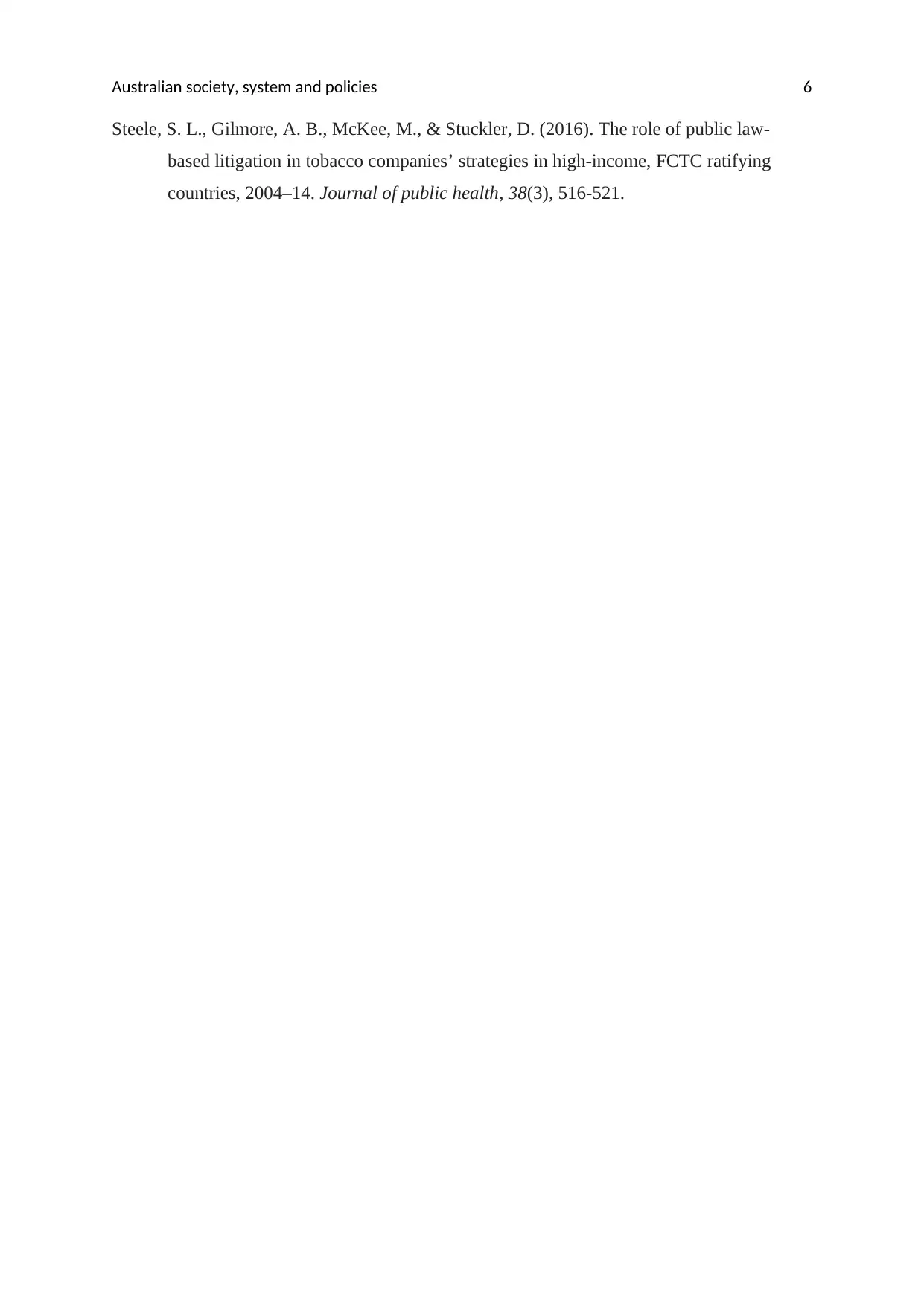
Australian society, system and policies 6
Steele, S. L., Gilmore, A. B., McKee, M., & Stuckler, D. (2016). The role of public law-
based litigation in tobacco companies’ strategies in high-income, FCTC ratifying
countries, 2004–14. Journal of public health, 38(3), 516-521.
Steele, S. L., Gilmore, A. B., McKee, M., & Stuckler, D. (2016). The role of public law-
based litigation in tobacco companies’ strategies in high-income, FCTC ratifying
countries, 2004–14. Journal of public health, 38(3), 516-521.
1 out of 7
Related Documents
Your All-in-One AI-Powered Toolkit for Academic Success.
+13062052269
info@desklib.com
Available 24*7 on WhatsApp / Email
![[object Object]](/_next/static/media/star-bottom.7253800d.svg)
Unlock your academic potential
© 2024 | Zucol Services PVT LTD | All rights reserved.




